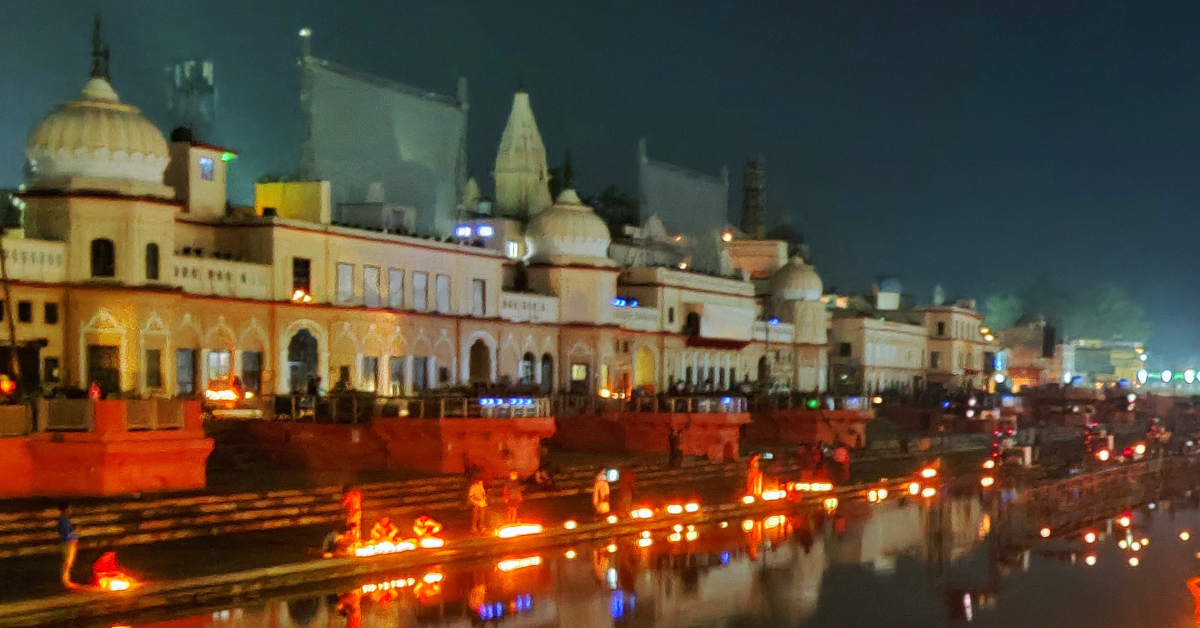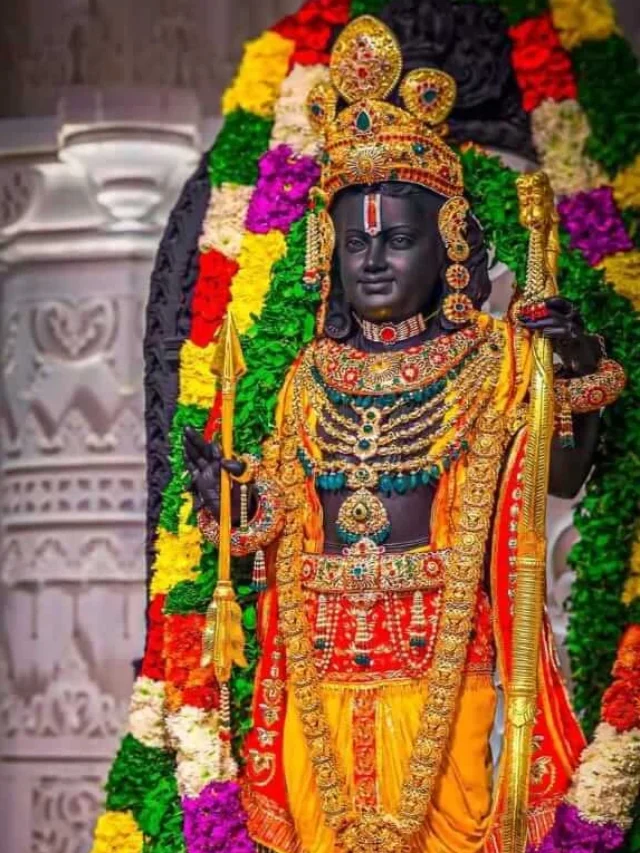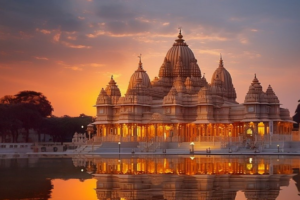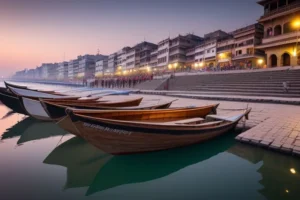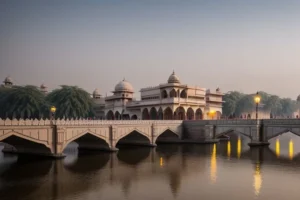Ayodhya, the birthplace of Lord Rama and a city steeped in ancient Hindu mythology, beckons travelers seeking spiritual solace and cultural immersion. With the completion of the magnificent Ram Mandir, the Ayodhya Travel has become a magnet for millions of devotees eager to pay their respects at this sacred site.
Table of Contents for Ayodhya Travel
Planning Your Pilgrimage:
Best Time to Ayodhya Travel
October to March offers pleasant weather, while April to June sees scorching summers. Monsoon months (July to September) can be humid, but witness fewer crowds. Diwali and Ram Navami are particularly busy periods.
Getting There
Ayodhya boasts its own airport (AYD) with connections to major cities. Trains to Ayodhya Junction (AY) and Faizabad Junction (FD) are abundant. Buses offer budget-friendly travel from Lucknow and Varanasi.
Accommodation
Ayodhya caters to a range of budgets, from dharamshalas and budget hotels to luxurious stays. Booking well in advance, especially during peak seasons, is recommended.
Experiencing the Divine Ayodhya Travel:
Darshan at Ram Mandir
The star attraction, the majestic Ram Mandir, allows free entry for darshan. Expect queues, especially during peak hours. Consider booking a “Seva” ticket online for quicker access. Mobile phones and cameras are prohibited inside the complex.
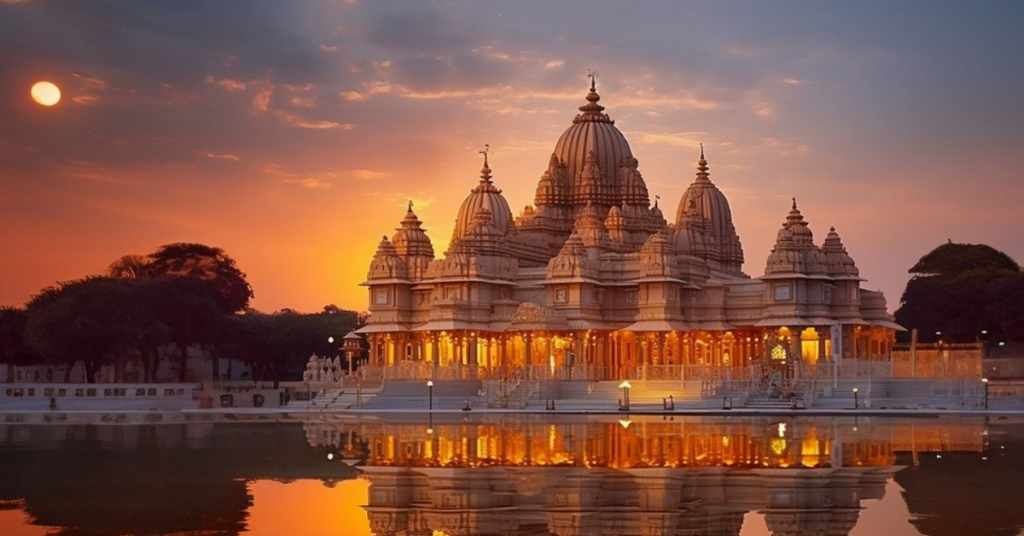
A Dream Realized Ayodhya Travel to Shri Ram Mandir
For centuries, the construction of a grand Ram Mandir at the birthplace of Lord Rama remained a fervent desire for Hindus. After years of legal battles and unwavering devotion, the dream materialized in 2020 with the laying of the foundation stone. Today, the majestic Ram Mandir stands tall, a testament to faith, resilience, and architectural brilliance.
Architectural Splendor of Ram Mandir Ayodhya
The Ram Mandir is a symphony of Rajasthani and Pahari architectural styles, adorned with intricate carvings and sculptures depicting scenes from the Ramayana. The sanctum sanctorum houses the idols of Lord Rama, Sita, Lakshmana, and Bharata, crafted from black Makrana marble. Every facet of its design resonates with the spirit of the Ramayana, whispering tales of Lord Rama’s epic journey through intricate carvings, towering shikharas, and harmonious blend of traditional styles.
A Symphony of Styles
The architects masterfully wove together elements of Rajasthani and Pahari architectural styles, each contributing a unique charm to the edifice. The grand red sandstone exterior, reminiscent of Rajasthan’s forts, exudes an aura of strength and permanence. Meanwhile, the intricate carvings and delicate marble work, inspired by Pahari craftsmanship, infuse the structure with an air of elegance and intricate beauty.
Soaring towards the Heavens
Dominating the skyline are the five majestic shikharas, each symbolizing the Panchajanya conch, Lord Rama’s divine weapon. Rising in tiers, adorned with amalaka (disc-shaped ornaments) and kalashas (decorative pots), they reach towards the heavens, mirroring the aspirations of countless devotees.
A Journey Through the Ramayana
The walls of the mandir become a canvas for narrating the Ramayana. Exquisite stone carvings depict scenes from the epic, from Rama’s birth to his coronation, each panel a testament to the skill of the artisans. These visual stories not only enhance the aesthetic appeal but also deepen the spiritual connection for pilgrims.
A Sanctum of Serenity Ram Mandir Ayodhya
The inner sanctum sanctorum, the heart of the temple, houses the black Makrana marble idols of Lord Rama, Sita Ji, Lakshmana Ji, Hanuman Ji and Bharata Ji. The darkness within accentuates the radiant glow of the deities, creating a mesmerizing aura of reverence and divine presence.
Beyond the Grandiose Ayodhya Ram Mandir
The architectural marvel extends beyond the central mandir. The complex encompasses spacious courtyards, serene water bodies, and intricately carved mandapas (pavilions), each serving a distinct purpose. Pilgrims can unwind in the tranquil courtyards, seek blessings at smaller shrines, or witness the mesmerizing Saryu Aarti, where hundreds of lamps illuminate the riverbank in a nightly spectacle of devotion.
A testament to faith, dedication, and architectural mastery, Ram Mandir in Ayodhya is not just a place of worship; it’s a masterpiece that speaks volumes about India’s rich cultural heritage and enduring spiritual legacy.
Experiencing the Divine Shri SiyaRam
Visiting the Ram Mandir is an experience that transcends the physical. As you enter the complex, a sense of serenity washes over you. The rhythmic chanting of hymns, the wafting fragrance of incense, and the vibrant dhotis of devotees create an atmosphere of profound devotion.
Ayodhya Travel Darshan
The ultimate goal for pilgrims is to have a darshan, a glimpse of the deities. The queues for darshan can be long, but the wait is imbued with anticipation and a shared sense of purpose. When you finally stand before the idols, the feeling of connection with the divine is palpable.
Beyond the Mandir
The Ram Mandir complex is not just a temple; it’s a spiritual sanctuary. Explore the Ram Katha Sangrahalaya, a museum showcasing the Ramayana through exhibits and dioramas. Take a dip in the holy Saryu River, believed to cleanse sins. Witness the mesmerizing Saryu Aarti, a daily ritual where hundreds of lamps illuminate the riverbank.
Saryu Aarti
Witness the mesmerizing evening aarti ceremony along the Saryu River, a deeply spiritual and visually stunning experience.
Explore Ayodhya’s Heritage
Immerse yourself in the city’s rich history through landmarks like Kanak Bhavan, Hanuman Garhi, and Nageshwarnath Temple.
Kanak Bhavan
Kanak Bhavan is a temple dedicated to Lord Rama and his wife, Sita. The temple is located on the banks of the Saryu River and is known for its beautiful architecture and gold-plated idols. The temple was built in the 19th century by the queen of Tikamgarh, Madhya Pradesh.
Hanuman Garhi
Hanuman Garhi is a temple dedicated to Lord Hanuman, the monkey god. The temple is located on a hilltop overlooking the city of Ayodhya. It is believed that Lord Hanuman used to live here to protect Lord Rama’s kingdom. The temple is known for its imposing structure and the 76 steps that lead up to it.
Nageshwarnath Temple
Nageshwarnath Temple is a temple dedicated to Lord Shiva, the Hindu god of destruction and regeneration. The temple is located on the banks of the Saryu River. It is believed that the temple was built by King Vikramaditya in the 2nd century BC. The temple is known for its beautiful architecture and the lingam (phallic symbol) of Lord Shiva.
Beyond the Mandir, Ayodhya Travel
Ayodhya boasts several other spiritual sites, including Sita Ki Rasoi, Gupta Ghat, and Chakravartula Court.
Sita Ki Rasoi Temple, Ayodhya: A Culinary Canvas of Devotion
Step back in time to the era of Queen Sita, the epitome of grace and devotion, at Sita Ki Rasoi. This quaint temple, believed to be the site of her kitchen, is more than just a historical landmark. It’s a living testament to her selfless spirit and culinary skills.
Architectural Allure
The temple boasts a traditional Indian architectural style, with a red sandstone facade and intricate carvings depicting scenes from the Ramayana. The serene ambiance within invites quiet contemplation and prayer.
A Legacy of Service
As legend goes, Sita used this very kitchen to feed the poor and hungry during Lord Rama’s reign. Today, devotees offer prasad (blessed food) here, continuing the tradition of selfless service and carrying the essence of Sita’s compassion.
Experience the Essence
Immerse yourself in the devotional atmosphere by partaking in the daily aarti ceremony or simply soaking in the tranquility of the space. Don’t miss the free prasad offered after the aarti, believed to be infused with Sita’s divine touch.
Gupta Ghat: A Serene Sanctuary on the Saryu
Descend the ancient steps leading to Gupta Ghat, a hidden haven on the banks of the sacred Saryu River. This secluded spot, shrouded in myths and legends, offers a unique perspective on Ayodhya’s spiritual tapestry.
Mythological Mystique
Legend has it that Lord Rama used this ghat for his ablutions during his reign. It’s also believed to be the place where Lakshmana, his brother, crossed over to the afterlife. This rich mythological association imbues the ghat with an air of mysticism and reverence.
Tranquil Escape
Seek solace in the serene atmosphere of the ghat. Witness the sun paint the Saryu in golden hues as you meditate by the water’s edge, or lose yourself in the rhythmic chanting of hymns emanating from nearby temples.
Boat Blessings
Take a traditional wooden boat ride on the Saryu for a picturesque perspective of Ayodhya’s skyline. Witness the vibrant life along the riverbanks and experience the calming embrace of the water.
Chakravartula Court: A Glimpse into Royal Ayodhya Travel
Travel back to the glorious era of King Dasharatha, Lord Rama’s father, at Chakravartula Court. This ancient site, believed to be the royal treasury and assembly hall, offers a glimpse into the opulence and grandeur of Ayodhya’s golden age.
Architectural Grandeur
The ruins of the court, though weathered by time, still showcase intricate carvings and remnants of grand pillars, hinting at the architectural magnificence of the bygone era.
Royal Relics
Discover remnants of ancient pottery, coins, and other artifacts unearthed from the site, offering tangible evidence of a glorious past.
Historical Significance
Immerse yourself in the historical significance of the court. Imagine royal assemblies, strategic discussions, and celebrations that once took place within these very walls.
Visiting these hidden gems in Ayodhya is a delightful adventure for any explorer seeking to go beyond the obvious.
Making Your Ayodhya Travel Trip Memorable:
- Dress modestly: Respect local customs by dressing conservatively, especially while visiting religious sites.
- Footwear: Be prepared to remove your shoes at temples and other sacred places.
- Photography: Photography is generally prohibited inside religious sites. Check signage before clicking pictures.
- Local Delicacies: Savor Awadhi cuisine, known for its rich flavors and aromatic spices. Try “samose ki chaat,” “bedmi puri,” and Awadhi kebabs.
Ayodhya is more than just a pilgrimage destination; it’s a window into India’s vibrant culture and spiritual heritage. Whether you’re a devout Hindu or simply seeking a unique travel experience, Ayodhya promises an unforgettable journey that will touch your soul.
Frequently Asked Questions (FAQs)
Unveiling the Sacred City of Ayodhya, Reaching Ayodhya, the Abode of Lord Rama:
Is Ayodhya Safe to Visit Now?Ayodhya is generally safe for tourists. As with any destination, stay informed about current situations and exercise caution in unfamiliar areas.
Can I Visit Ayodhya Now? Yes, Ayodhya is open for tourism.
How to Travel to Ayodhya? By Air: The nearest airport is Ayodhya Airport (AYD) (limited connectivity). Many visitors fly into Lucknow International Airport (LKO) and then travel to Ayodhya by road.
By Train: Ayodhya Junction Railway Station offers train connectivity to various cities.
By Road: Ayodhya is well-connected by buses and taxis from major cities like Delhi, Lucknow, Varanasi, Agra, Kanpur, and Allahabad. Check online for specific routes and fares from your city.
Exploring the Spiritual Heart of India:
Why Visit Ayodhya? Ayodhya holds immense significance for Hindus, as it is revered as birthplace of Lord Rama. It’s a pilgrimage destination offering:
Spiritual Sites: Visit the grand Ayodhya Ram Mandir and other holy sites associated with Ramayana.
Historical Significance: Explore its rich past and archaeological sites.
Festivals: Immerse yourself in the vibrant celebrations during Dussehra and Diwali.


